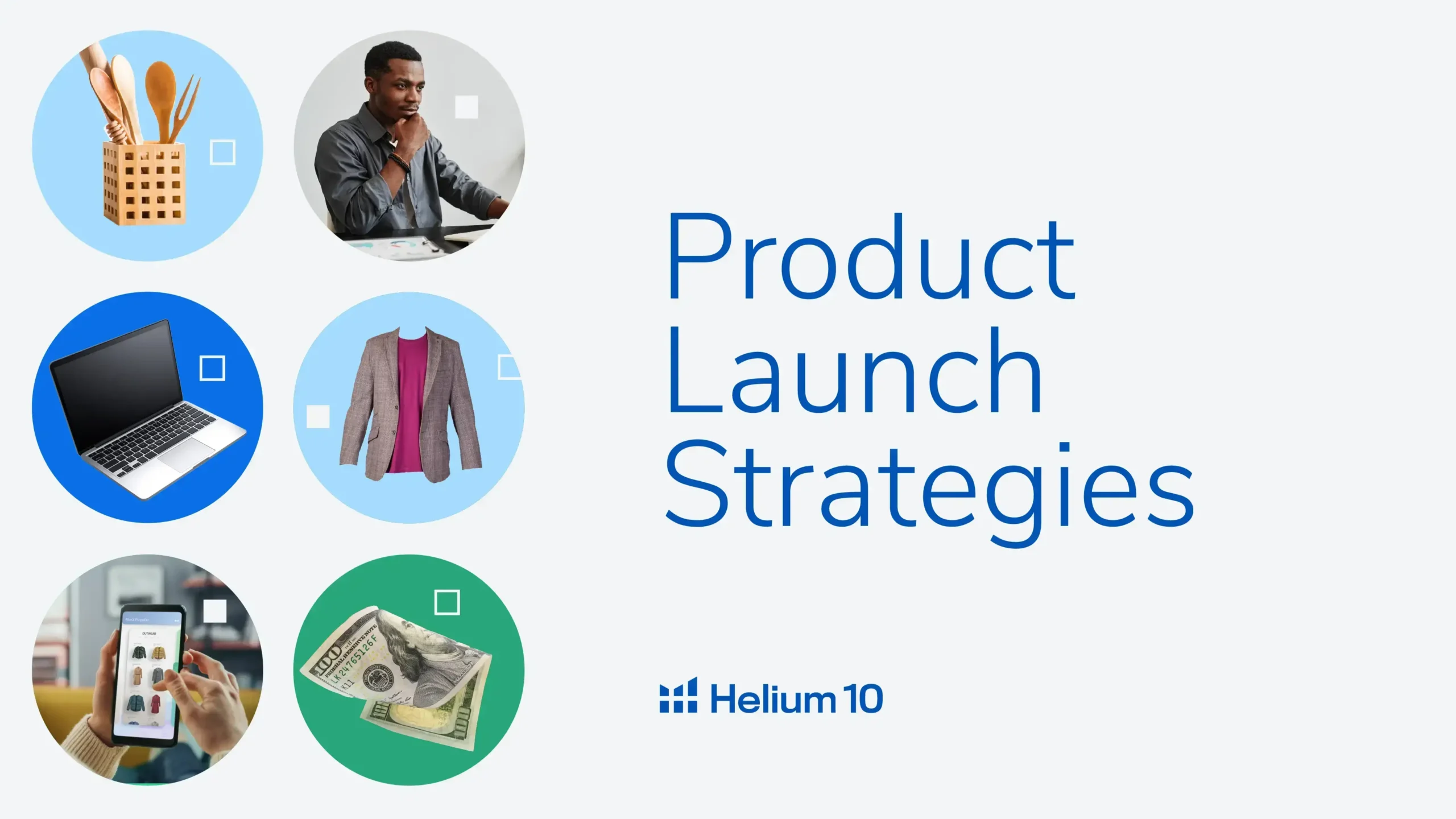
Amazon Product Launch Strategies for More Sales


Table of Contents
- Introduction
- First, What Is an Amazon Product Launch?
- Is It Hard to Launch a Product on Amazon?
- How Long Does It Take To Launch a Product on Amazon FBA?
- Why Should I Launch a New Product on Amazon?
- What Are Common Challenges Launching a New Product on Amazon?
- So, How Do You Find a New Amazon Product to Sell?
- Some Amazon Product Launch Strategies
- Join the Vine Program
- Product Discoverability and Conversion
- Vine Dashboard
- Conduct Thorough Keyword Research
- Be Intentional About Your Keywords
- Uncover Keywords with Cerebro
- Keyword Rank Versus Keyword Index
- Long-Tail Keywords
- Maldives Honeymoon Effect
- Product Launch Strategy Using Seller Central
- Optimize Your Product Listing
- Offer Exclusive Discounts to Your Email List
- Promote on Social Media Platforms
- How to Increase Brand Visibility
- Leverage Social Media Influencers
- Authentic Reviews and Amazon Product Demonstrations
- Expand Audience Reach and Engagement
- Run Amazon PPC Campaigns
- Analyze Performance Data and Adapt Your Strategy
- Reach Out to Build Reviews
- Amazon Product Launch Checklist
- Put it into Application
Introduction
If you’re not marketing, you’re not selling—it’s as simple as that. But when it comes to launching a product on Amazon, what’s the proper mixture of techniques to help you get your brand the visibility you’re hoping for?
It’s no longer 2012 where you can just throw up a product and win the algorithm with solely sales velocity. Launching a product on Amazon in 2025 requires a blend of traditional and innovative strategies.
With growing competition, updates to Amazon’s tools, and shifting consumer behaviors, you’ll want to keep reading ahead to stock up on some proven Amazon product launch strategies that can help you enhance visibility, boost sales, and guide you toward a successful Amazon product launch.
Whether you’re a new seller or an experienced one looking to refine your launch approach, stick around.
First, What Is an Amazon Product Launch?
An Amazon product launch is the strategic introduction of a new product—or reintroduction of an existing one—to maximize its visibility, generate sales, and establish a foothold in the competitive Amazon marketplace.
The key goals are to position the product in front of the right audience, create a buzz to generate interest, and ultimately drive conversions for the product by encouraging them to make a purchase so you can walk away with an arsenal of positive reviews to uplift overall performance on the platform.
Is It Hard to Launch a Product on Amazon?
Well, that really depends. Revenue generation is largely impacted by your product or brand’s available social proof. Securing those first few sales when you have no social proof whatsoever may seem challenging.
Yet with a sufficient budget, a quality product, and a properly crafted methodology for review acquisition with a little help from software like ours in combination with external traffic can change the outcome of the chessboard you are playing in a positive manner.
A comprehensive product launch strategy can include anything from doing press releases and posting in Facebook groups to running targeted advertising campaigns and doing giveaways through collaborating with TikTok creators. Offering limited-time promotions, utilizing discounts, or bundling products are also effective tactics to entice buyers and encourage initial purchases.
However, none of those things will ever matter if your product listing page is unoptimized. Marketing is for traffic. Your product listing pages are for conversions, and having an optimized listing with relevant keywords, compelling visuals, and detailed product descriptions is what will help you convert.
Note that in 2025, niche markets are tighter, but tools like Helium 10’s AI-powered insights make identifying opportunities easier and Amazon’s policies have evolved, especially around review solicitation and external traffic so you’ll want to be well-versed on those to ensure you stay in compliance.
How Long Does It Take To Launch a Product on Amazon FBA?
The time it takes to launch a product on Amazon FBA varies. From conceptualization to the first sale, the process can span anywhere from a few weeks to a few months. Factors affecting the timeline include product complexity, sourcing, shipping, listing optimization, and market research.
Why Should I Launch a New Product on Amazon?
Launching a new product on Amazon can help you boost your sales while simultaneously expanding your brand’s offerings and reach.
Introducing a fresh item brings novelty to your offerings, attracting both existing and new customers. It allows you to tap into evolving market trends, meet unmet consumer needs, and stay ahead of competitors.
Additionally, a new product can rejuvenate your store’s appeal and invigorate interest in your brand, further driving revenue growth.
What Are Common Challenges Launching a New Product on Amazon?
Challenges remain, but they’ve evolved.
Let me preface this section by saying challenges are a natural part of both any business and life in general. Keep in mind that how you approach them will always be more important than the hurdles themselves.
Now? Amazon’s algorithm places greater emphasis on external traffic and customer engagement metrics. There’s increased advertising costs. With higher demand for ad placements, mastering PPC is non-negotiable.
But naturally on Amazon, one of the most common hurdles is competition.
How do you stand out amidst a sea of products? And how do you do it when you wear most if not all the hats? Is there a “right way” to gather and interpret data to make informed decisions without feeling overwhelmed to get where you want to go?
AKA navigating Amazon’s algorithms and staying compliant with its changing policies, managing inventory, logistics, and ads PLUS ensuring a seamless customer experience.
None of these are impossible to overcome and with some effort, you can be well on your way to having a successful product launch.
So, How Do You Find a New Amazon Product to Sell?
You could go product surfing in stores, browse through best sellers lists on Amazon or any other third-party platform like Etsy or Pinterest, or find a new Amazon product to sell after sifting through backend data with a tool like Helium 10’s Black Box.
Products with high demand and relatively lower competition are better equipped to handle new sellers.
Assess customer reviews and feedback to understand market preferences and pain points, aiding you in selecting a product that aligns with consumer needs.
For a more in-depth understanding of what to look for, read up on Amazon product research here.
Some Amazon Product Launch Strategies
While there is not a definitive formula to catapult a newly launched product to success, there are some pre-launch strategies you could do to make product launches more accessible and cost-effective as a seller.
Join the Vine Program
If it’s the first few reviews you have been most worried about, rest assured there’s also the Vine Program. Amazon Vine is a program designed to provide trusted reviewers, known as Vine Voices, with the opportunity to review products for free in exchange for their honest and unbiased opinions. These reviews, also known as Vine reviews, serve as a powerful source of social proof, offering potential customers valuable insights into product functionality and suitability.
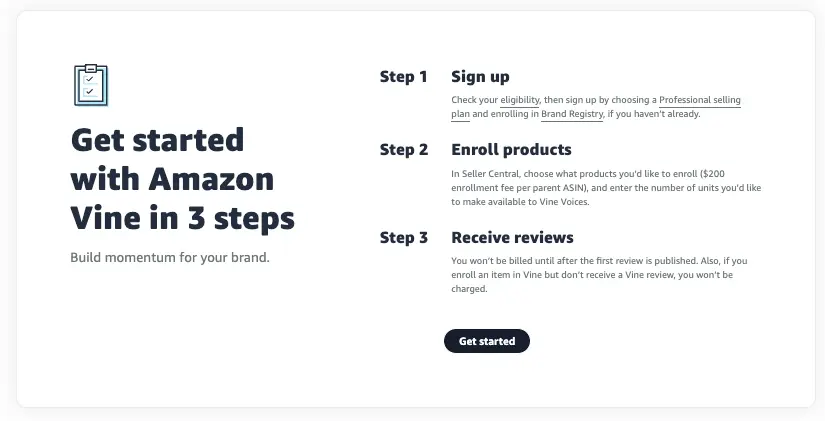
Product Discoverability and Conversion
One of the key benefits of Amazon Vine is its ability to improve product discoverability and conversion. Sellers can enroll in Amazon Vine to receive up to 30 high-quality customer reviews per product page, with studies showing that Vine reviews can boost sales by up to 30%, making them a valuable asset for increasing conversion rates.
Furthermore, the program allows sellers to build rapport with customers by engaging Vine Voices, trusted reviewers in the Amazon community, who provide authentic feedback, helping to build trust with potential customers.
For products struggling to gain attention, Vine reviews offer a valuable solution by providing a boost in social proof and credibility. This is particularly useful for gaining traction for new or slow-moving products. Detailed Vine reviews also help customers make informed purchase decisions. By offering potential buyers the information they need, sellers can reduce the likelihood of returns and negative feedback while gaining insights for improving their offerings and growing their business.
For the moment, the Amazon Vine program operates through a convenient enrollment process. Sellers can sign up by checking their eligibility and choosing a Professional selling plan while enrolling in Brand Registry if necessary. The enrollment process allows sellers to enroll up to 200 ASINs at a time, making it a convenient and scalable option.
To facilitate the review process, sellers can provide free units for Vine Voices to review by enrolling their products in Fulfillment by Amazon (FBA) and listing them in the Amazon store. Sellers can offer up to 30 free units, and Vine Voices receive a link to the product page. Claimed Vine units appear on order reports with a price of $0 and no customer name visible, preserving the anonymity of Vine Voices.
Vine Dashboard
From there, sellers can use the Vine Dashboard to track reviews and monitor the impact on their products, providing a streamlined and intuitive process. In terms of cost, there is an enrollment fee per parent ASIN, and there is no charge for child ASINs attached to an enrolled parent ASIN. Sellers are billed only after the first review is published, and no charges are incurred if a Vine review is not received for an enrolled item.
Additionally, sellers cover the cost of referral fees and Fulfillment by Amazon fees for Vine products. If Vine reviewers do not claim Vine-enrolled inventory, it can still be purchased by Amazon customers through FBA, with standard FBA fees applying.
Conduct Thorough Keyword Research
The second (in no particular special order of importance) is to do thorough keyword research.
Be Intentional About Your Keywords
Be intentional about which keywords make it to the final cut of your listing. You will want to opt for terms with substantial search volume, and take a close look at competitors’ keywords to identify opportunities.
And what better way to do that than by using Cerebro and Magnet, Helium 10’s keyword research tools?
Here are some specific strategies you can use when performing a reverse Amazon Standard Identification Number (ASIN) keyword search using any competitor ASINs inside of your niche.
First, reverse engineer your competitor’s PPC strategy by taking a look at the Sponsored Rank average. Put a sponsored rank average from 1-30 in conjunction with something like a minimum search volume (though it is not necessary). Then, look for (1) how many competitors are advertising for the keyword and (2) what their sponsored rank average is, meaning what is the average ranking placement on search result pages for the selected ASINs.

As an example, if I only used 3 ASINs and those three competitors ranked at 3, 7, and 14, my sponsored rank average would be 8.
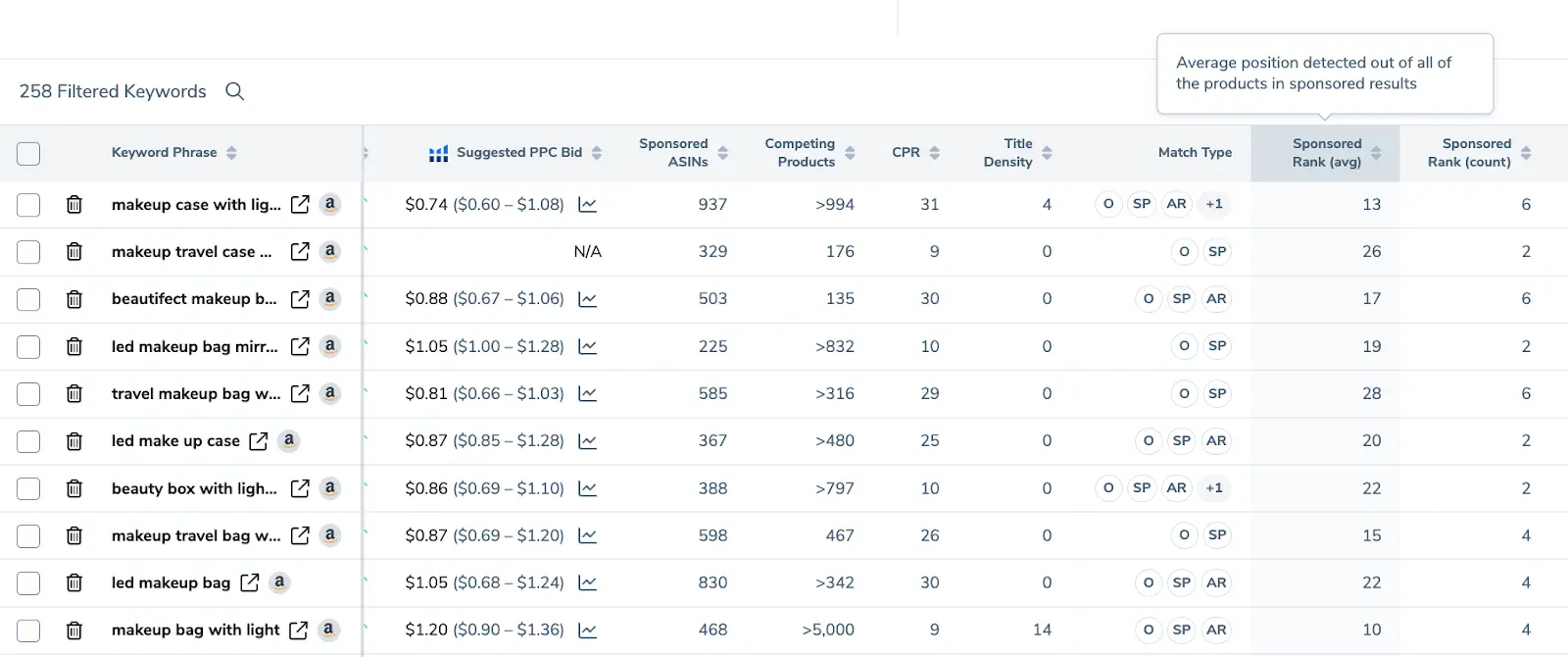
These keywords can help determine which keywords are worth going after and what terms competitors deem important enough to pay money for to be at the top of search results with a high bid.
Uncover Keywords with Cerebro
With Cerebro, you can also use the one-click filters provided at the top of the tool (Top Keywords and Opportunity Keywords) with multi-ASIN searches to uncover keywords that most of your competition is using or missing out on.

Keyword Rank Versus Keyword Index
For key phrases that you want to index for, but do not need to necessarily rank in the top 10 positions for, you could put in a minimum search volume and use the Advanced Rank Filter 1/2 with a minimum of 1, and Advanced Rank Filter 2/2 where the range is 1 to 100. This means at least 1 is ranked in the first two pages. These particular keywords could potentially get me sales in the future.
Long-Tail Keywords
For long-tail keywords stemming from a list of the top 20-30 main keywords you may have already accrued, you could start with a seed keyword search (1 root word) inside of Magnet, click Get Keywords, and then engage the Smart Complete filter to reveal long-tail versions and singular or plural versions of the initial keyword you typed in. These can be a part of the secondary keywords you will want to index for. Or even gauge buyer intent through the word count filter to understand which terms will prove most impactful for you. Sometimes, you could potentially become the first to rank for a relevant keyword! You never know until you really start digging for gold.
Speaking of ranking first for a keyword, an out-of-the-box tactic you could use is to start looking at related products that are frequently bought together to use as supplementary search terms. You can do this inside of the product targeting tab of Black Box to see which products were frequently bought together with your product and gather some loosely relevant, good sales volume key phrases. Though a makeup bag with a light-up mirror is not the same as a portable jewelry organizer, the consumer who purchases one will likely be interested in the other as both cater to the idea of staying organized while traveling in the beauty niche.
Maldives Honeymoon Effect
In former Serious Seller’s Podcast episodes, Bradley has also described something dubbed as the “Maldives Honeymoon Effect.” He recounts various experiments, such as using search-find-buy campaigns for specific keywords and observing remarkable results with minimal giveaway units. The key findings include the significance of having the target keyword in the title, exploring related keywords that may not be explicitly mentioned in the title, and leveraging the theory of the “Maldives Honeymoon” to achieve impressive search ranking outcomes.
Providing examples from projects involving wooden egg holders, straws, hemp creams, and a $5,000 product launch, he highlights the impact of targeting niche keywords with low competition and having the seed keyword in the title for increased relevance. Additionally, Sutton shares a recent case study where he launched a new product with a search volume of 4,000, rapidly ascending from position 100 to page one, position one, within five days. The “Maldives Honeymoon” approach involves strategic targeting of keywords, exploiting minimal competition, and ensuring rapid sales generation during the initial stages of a product’s listing and this is something you can test for your own products using the Title Density feature inside of Cerebro!
Product Launch Strategy Using Seller Central
Alternatively, if you do not yet have Helium 10 at all, you can always use the Opportunity Explorer inside of Seller Central even if you don’t have Brand Registry. Enter your competitors’ products and find the niches that the product appears in. These are niches of 10-30 search terms you can use to find keywords for your listings and PPC campaigns.
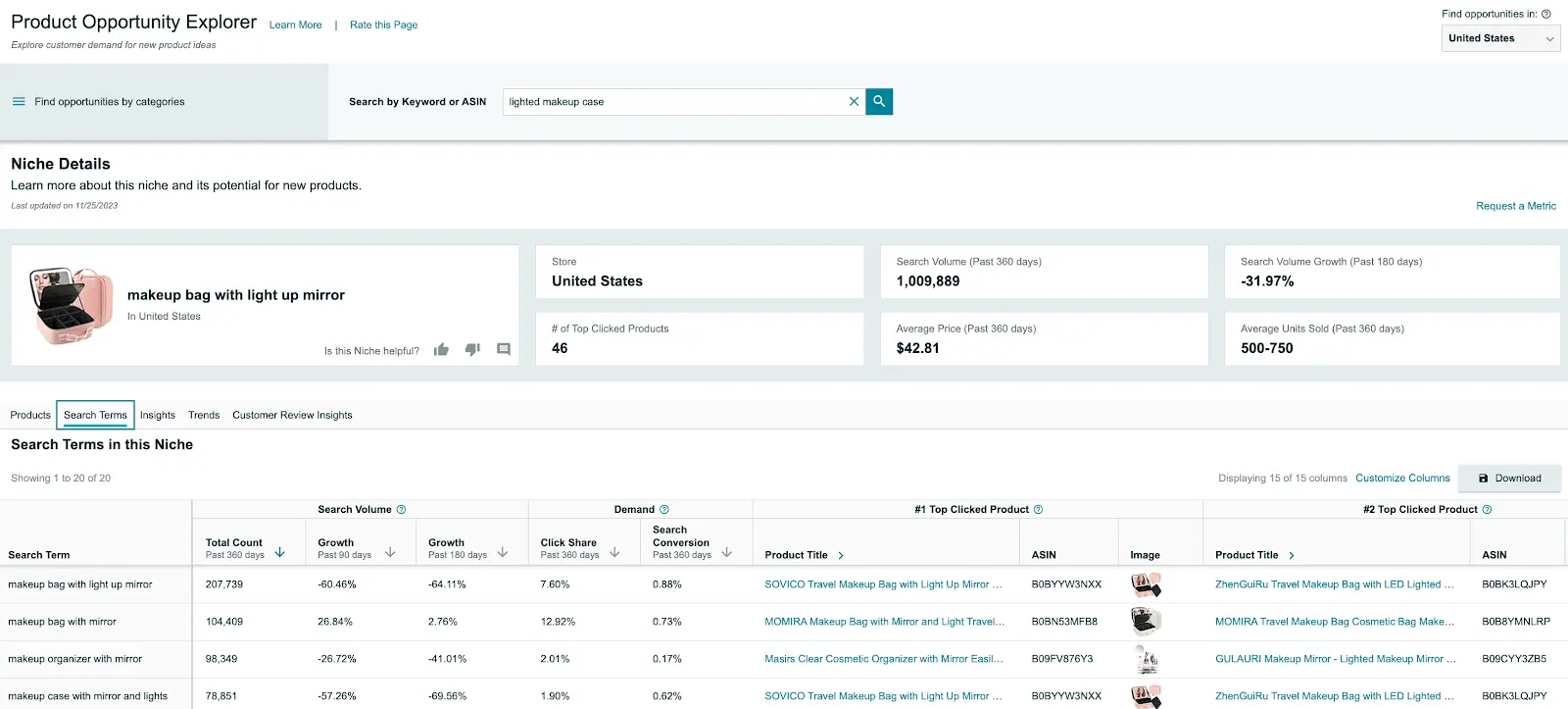
There are many more means of discovering and selecting keywords. I recommend you give Serious Sellers Podcast Episodes 506, 507 508 (and all the other episodes) a listen!
Optimize Your Product Listing
Optimization is an ongoing activity, responsive to changes in the market and platform functionality.
This means that optimizing effectively goes beyond incorporating the right keywords into your listing. It is more than a mere character count and completion of crucial fields. It encompasses the quality of images, bullet points, and descriptions, as well as the strategic use of various A+ content types.
You will want to regularly update your listings to incorporate new features and extend your product line for the best buyer experience. Assess how each of those elements contributes to broader aspects like new trends, seasonality, and aesthetics.
Take some time to evaluate your search query performance considering insights into keyword performance, page and session views, conversion rates, and more.
If you have access to A+ content – utilize standard comparison charts for cross-selling or upselling, craft a compelling brand story to build trust, and leverage all 12 pieces of approved A+ content. Seize any new privileges offered by the platform to stay ahead of competitors.
Branding involves not only your brand story and customer and seller reviews but also addressing customer feedback promptly. Your copy serves not only to highlight product attributes and benefits but also to include keywords for better ranking and upfront addressing of concerns raised in reviews. Regularly review customer feedback, including discussions in relevant Facebook groups, to identify areas for improvement not explicitly mentioned in your listing or competitors’ listings. Tailor your messaging to the right audience, repelling the wrong ones to minimize negative feedback.
Last year, I wrote a piece after sitting down with Emma Schermer Tamir from Marketing by Emma and picked her brain on when and how to re-optimize listings and a lot of it still holds true so check it out here.
Offer Exclusive Discounts to Your Email List
Limited-time promotions, such as discounts, buy-one-get-one-free (BOGO), or percentage-off deals create a sense of urgency, encouraging customers to make a purchase sooner.
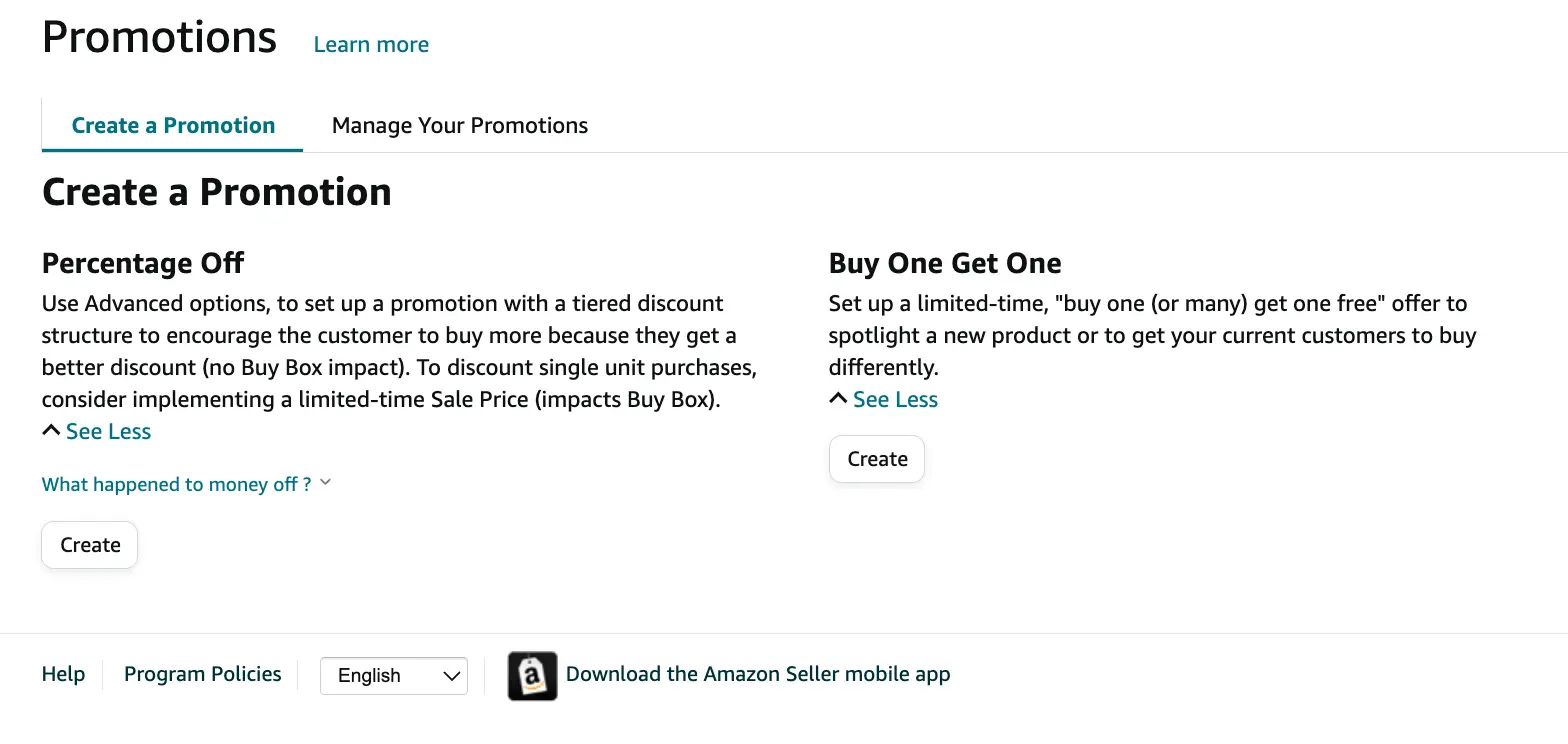
Utilizing discounts on products can attract cost-conscious buyers who are more willing to try a new product at a lower price. Sellers can create discount codes or coupons for their products, offering a reduced price during the checkout process. For example, the “20% Off” offer for the product is shown below.
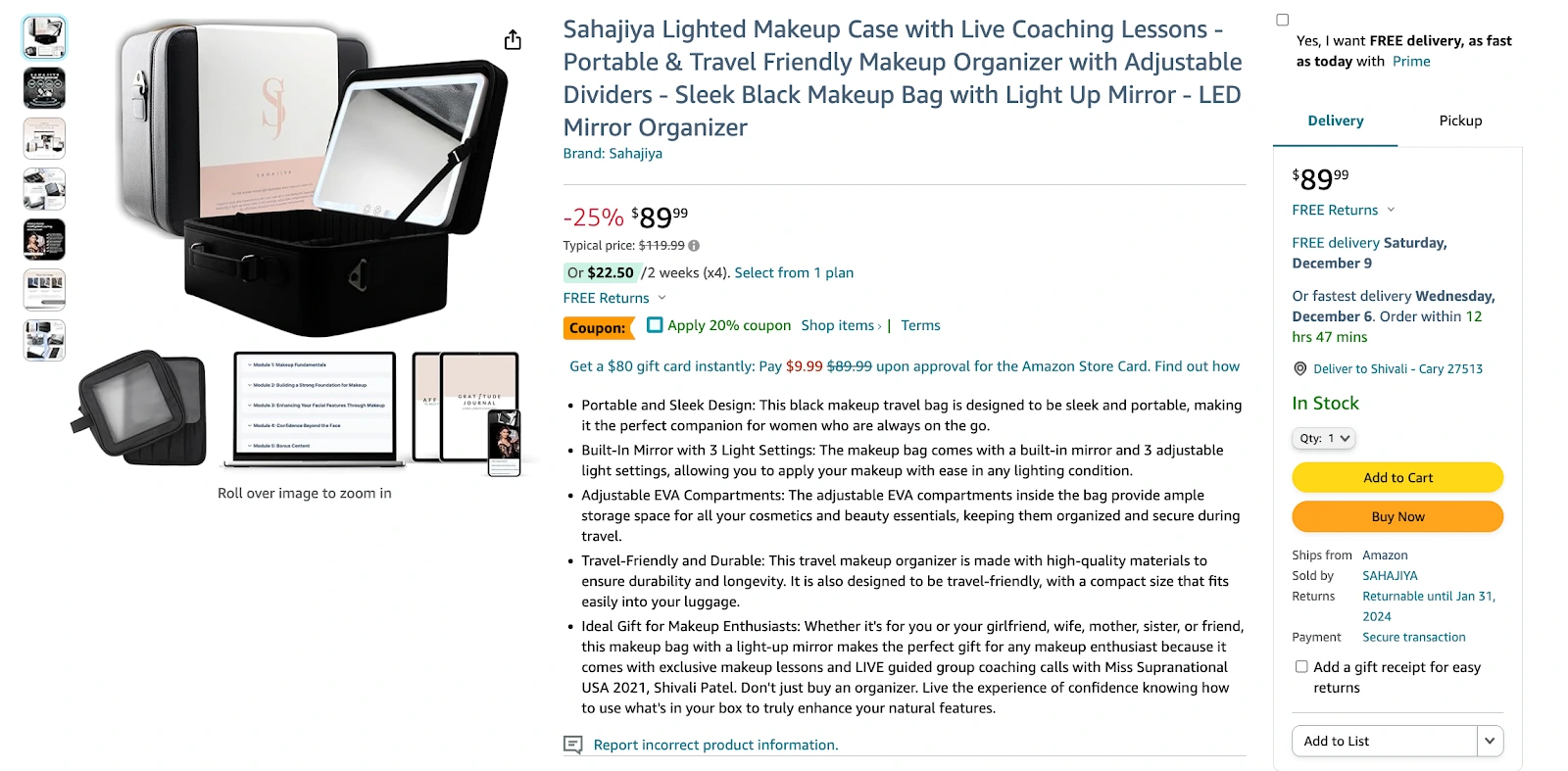
Promoting these discounts on product listings or through external channels can drive initial sales.
Another strategy involves bundling related products into a package deal to increase perceived value and encourage prospective buyers to make a purchase.
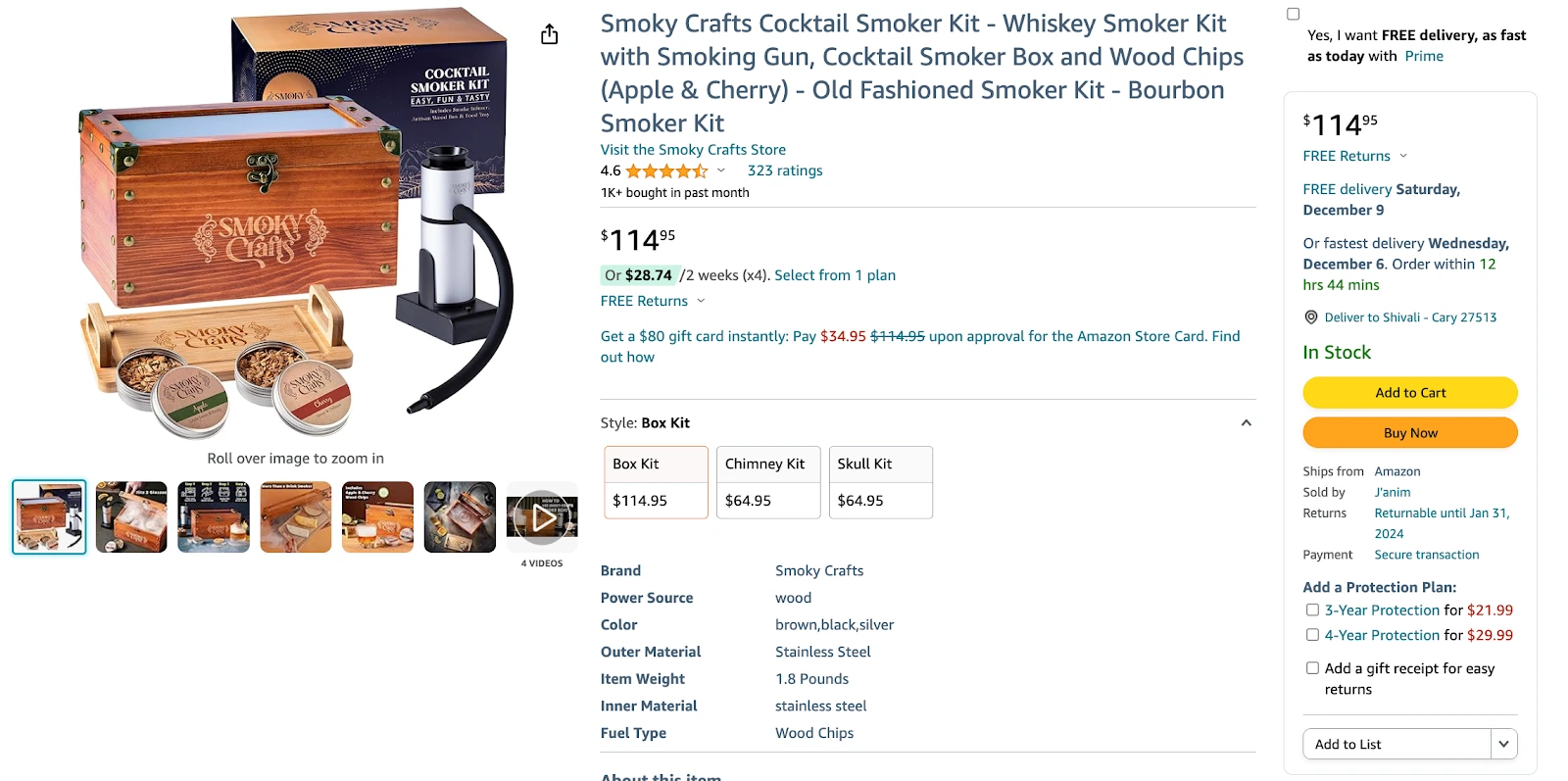
Sellers can bundle complementary products together, offering a discount when purchased as a package. This strategy can attract customers looking for comprehensive solutions or additional value. Testing different offers and promotions is important to determine what works best, especially as part of your product launch strategy.
Promote on Social Media Platforms
Utilizing platforms like Instagram, Facebook, and Twitter can also add ample opportunity to help you engage with a broader audience. Create visually appealing graphics to showcase your products, such as eye-catching images with vibrant colors, lifestyle photos demonstrating product use, and before-and-after shots for transformational products.
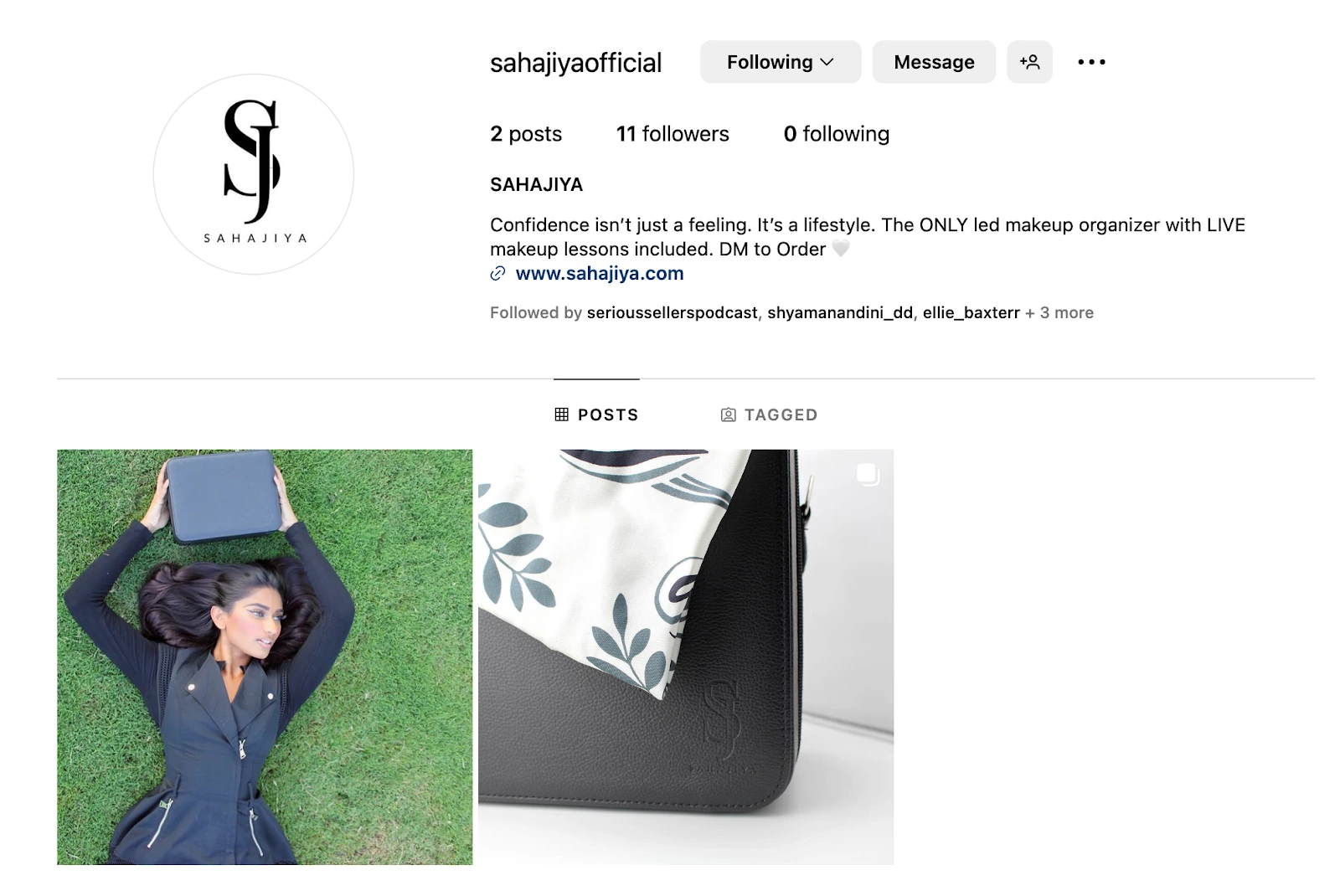
Additionally, infographics like the ones you create for your product listing images highlighting key features and benefits can capture attention and convey information concisely, so get more out of what you’ve built by posting and promoting it on social as well.
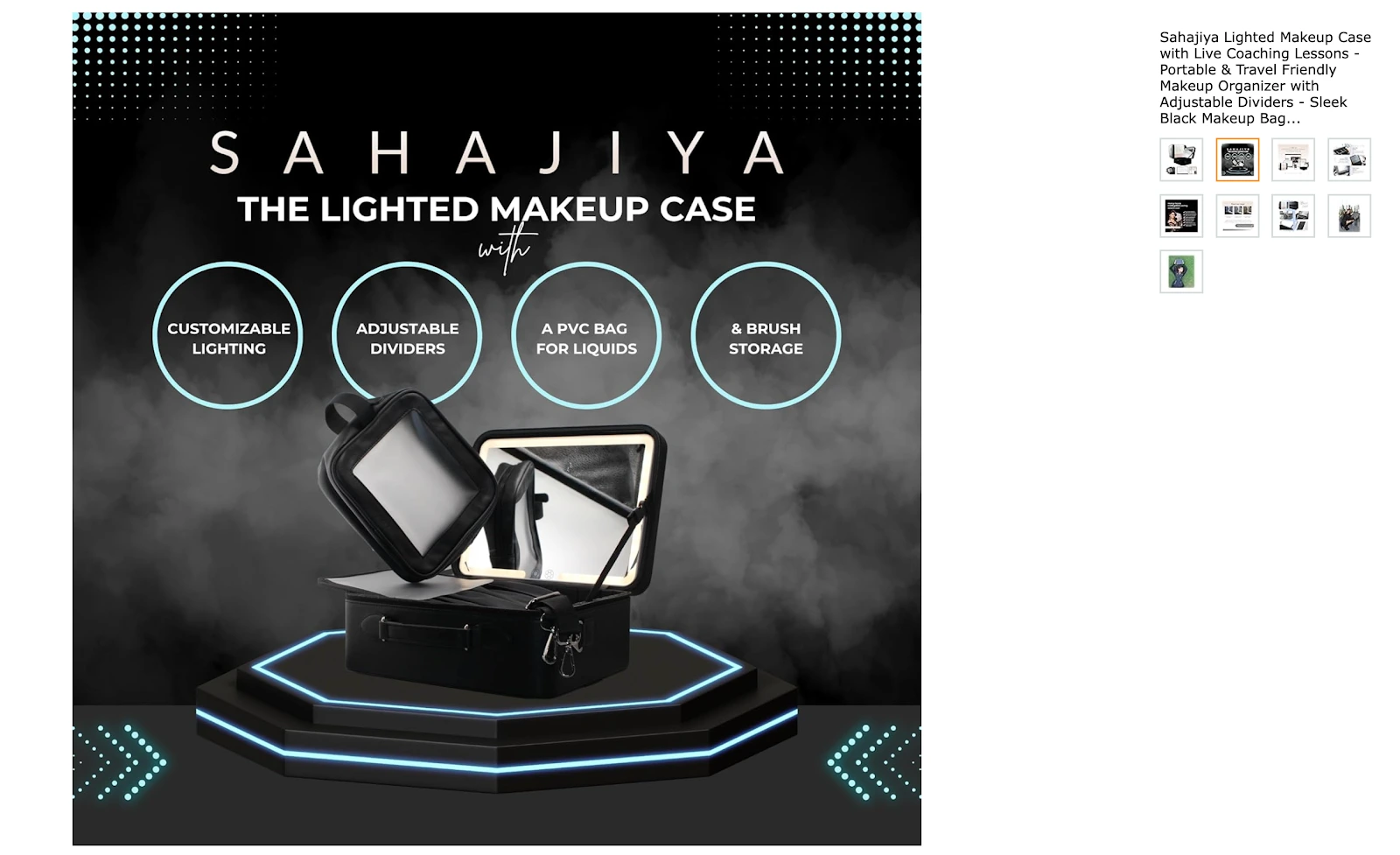
How to Increase Brand Visibility
As for enhancing brand visibility, I encourage you to incorporate branded content, including a consistent logo, color scheme, and typography across all social media posts for added professionalism.
Creating shareable content, like contests, giveaways, or polls, encourages audience interaction and extends the reach of promotional efforts. For instance, running a contest where participants share posts related to the product increases brand exposure.
If you don’t necessarily have the budget to post and promote original content frequently on social media after setting up your PPC campaigns, do not overcomplicate it. Taking high-quality photos and videos using an iPhone is an accessible and perfectly acceptable way for sellers to generate original content. Ensuring that you have good lighting, using the phone’s portrait mode for product shots, and experimenting with different angles can help yield professional-looking visuals.
Sellers can also explore apps like Canva, Adobe Photoshop, or iMovie for photo editing and video enhancement to add polish to their content.
For those seeking professional assistance, platforms like Fiverr and Upwork offer services for content creation. Sellers can hire graphic designers, photographers, or videographers to produce bulk content tailored to their brand.
Remember, outsourcing content creation allows sellers to focus on other aspects of their business while maintaining a consistent and professional image across social media platforms. By combining engaging graphics, consistent branding, and interactive content, Amazon sellers can effectively promote their products on social media, reaching a wider audience and driving traffic to their Amazon listings. Whether creating content independently using an iPhone or outsourcing to freelancers on platforms like Fiverr or Upwork, strategic social media promotion can contribute significantly to brand visibility and product sales.
Leverage Social Media Influencers
Outsourcing is a great place to discuss how to leverage social media influencers.
Influencer marketing is a strategic approach where individuals with a substantial online following collaborate with brands to promote products. As an Amazon (or Walmart, TikTok, or Shopify) seller, collaborating with influencers inside of your niche specifically can help you create the awareness you desire while simultaneously adding credibility, generating authentic reviews, and introducing the product to their audiences.
This marketing strategy involves scouting for relevant influencers in your market and leveraging their previously established reach to impact the purchasing decisions of their audience. Influencers often have a specific niche or demographic following, enabling sellers to precisely target their products to a relevant audience for a relatively cost-effective price.
These influencers, often deemed experts or celebrities of their space, build trust over time so when they genuinely endorse products, their audience is more likely to trust and act on those recommendations. This trustworthiness then positively influences how the product and brand are perceived.
Authentic Reviews and Amazon Product Demonstrations
Additionally, influencers can then provide authentic reviews and demonstrations of Amazon products, helping potential buyers understand the product’s features and benefits. Collaborative campaigns, such as giveaways, contests, or exclusive discount promotions, can create buzz around product launches or offer special incentives for the influencer’s audience to make a purchase. Some influencers participate in affiliate marketing programs, earning a commission for every sale generated through their unique affiliate links. This model creates a win-win situation where influencers are motivated to promote the product, and sellers only pay for actual sales.
Of course, when it’s all said and done, you can use any of the user-generated content created by influencers as social proof to showcase how others are using and benefiting from the product. How cool is that? Pretty cool, I think. I know I love free content I can repost.
Expand Audience Reach and Engagement
Plus, I’m sure you, your grandmother, and your dentist already know Amazon loves external traffic. Partnering with influencers also allows you as an Amazon seller to tap into existing communities, reaching potential customers who may not encounter their products through traditional advertising methods.
Nonetheless, the powerful combination of expediting trust by using an influencer’s authority or “celebrity status,” garnering sales through an external platform, and collecting reviews as the buyers use the product taps into Amazon’s flywheel of ranking higher and higher and you should do your best to use it to your advantage.
All I caution is to be sure to clearly define terms when making any deals, and ensure compliance with advertising and disclosure regulations.
Run Amazon PPC Campaigns
This one is pretty self-explanatory. Most of us don’t make it to Page 2 for products when we shop.
Since many shoppers on Amazon make purchase decisions based on the products they see first, running sponsored campaigns will help you show up at the top of your seed and supplementary keywords, increasing their visibility to your potential customers.
PPC campaigns can drive immediate sales for your products. When customers click on your ad and make a purchase, it contributes to your sales velocity. This can positively impact your product’s ranking on Amazon.
Amazon PPC also offers various targeting options, allowing you to reach specific audiences based on keywords, interests, or even specific products. This targeted approach ensures that your ads are shown to users who are more likely to be interested in your products. In 2025, it is more important than ever to highlight product use cases with engaging short videos, schedule ads during high-conversion times for maximum ROI and use features like sponsored brand videos to drive traffic to your storefront with professionally edited content.
With Amazon PPC, you get control over your advertising budget and bids. You can set a daily or lifetime budget, and you only pay when a user clicks on your ad. This provides flexibility and allows you to optimize your spending based on performance.
Analyze Performance Data and Adapt Your Strategy
From there, the valuable insights you then receive from running ads can be used to analyze the performance of your ads and make informed decisions about adjusting your campaign strategy, refining your product listings, and optimizing your overall Amazon selling strategy.
Compare the performance of different keywords. You can see which keywords are driving traffic and sales, enabling you to refine your organic keyword strategy for better long-term results.
Alternatively, you can also use Amazon’s Brand Analytics to track conversion rates by keyword, traffic sources (organic vs paid), and more.
Not sure where to begin with PPC? Expand your PPC knowledge with our Amazon PPC Academy.
Reach Out to Build Reviews
Not to mention, sellers can leverage email campaigns to reach out to customers post-purchase and encourage them to leave a review. Utilizing Amazon’s Buyer-Seller Messaging system, sellers can send polite and personalized emails thanking customers for their purchase and kindly requesting a review.
A pro-tip? Make life easier. Just use Helium 10’s Follow-Up tool.
Amazon Product Launch Checklist
Okay. So is your product ready? Is your keyword research done? Do you have your PPC campaigns set up? Influencer deals negotiated? Content scheduled? High-quality images shot? A plan in place for managing inventory effectively, an email drip campaign set up, or some sort of plan for post-launch follow-ups to maintain momentum and drive long-term sales?
If not, then it’s time to…
Put it into Application
Mastering the art of an effective Amazon product launch is fundamental to driving sales and fostering success on the platform.
But once you learn how to master online sales, you can do it all!
Carefully navigate the pre-launch, launch, and post-launch phases. Optimize your product listing, employ targeted advertising, and stay informed about market trends. Remember, adaptation and continuous improvement are key and can set your product on a trajectory toward success. Analyze your launch’s performance, learn from the data, and iterate your strategies for even better future launches. Here’s to your prosperous Amazon product launches and a thriving online business!
Achieve More Results in Less Time
Accelerate the Growth of Your Business, Brand or Agency
Maximize your results and drive success faster with Helium 10’s full suite of Amazon and Walmart solutions.

